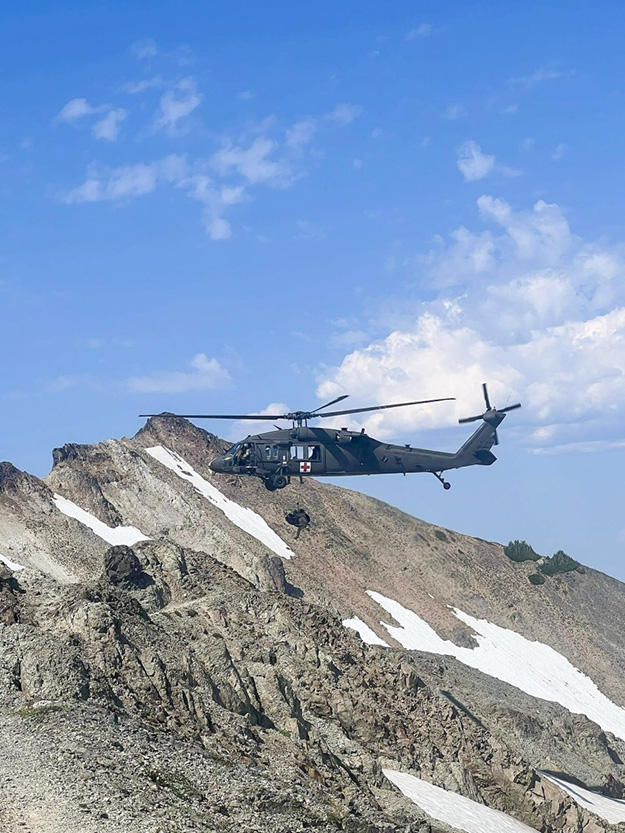YAKIMA TRAINING CENTER - Soldiers assigned to the United States Army Air Ambulance Detachment- Yakima (USAAAD-YTC) "Yakima Dustoff," 2-158 Assault Helicopter Battalion, 16th Combat Aviation Brigade performed multiple aeromedical evacuations of civilians in various locations across Washington last month.
Two aircrews from Yakima Dustoff performed three life-saving aeromedical evacuations between July 28, and 31, 2022.
"These were the first civilian rescue missions since early March that we supported. The late winter and cold spring kept hikers and climbers out of the mountains and recent warm temperatures made the wilderness accessible again," said Capt. Alec Degroat, commander of USAAAD-YTC.
The unit is based out of Yakima Training Center in central Washington. USAAAD-YTC operates 24 hours a day, seven days a week, to provide aeromedical evacuation support for thousands of service members training at Yakima Training Center each year.
Additionally, the detachment works with the Washington State Emergency Operations Center, local sheriff departments, and civilian volunteers to provide rescue coverage in south-central Washington's remote wilderness areas.
At approximately 2:17 p.m. on July 28, the first mission came in from the Lewis County Sheriff's Office, requesting assistance for a 31-year-old hiker who was suffering from severe dehydration on the Pacific Crest Trail in the Goat Rocks Wilderness.
Within 7 minutes of mission approval, DUSTOFF 762 suited up and swiftly responded to the call.
The flight crew navigated to the steep, rocky terrain to locate the injured hiker. After assessing the patient location, the team decided the use of a rescue hoist was the best course of action to extract the patient.
"We rarely know the full situation until an aircrew arrives on-scene, but we prepare to conduct a hoist extraction for any rescue mission. Our primary considerations are the survival of our patient, and safety of our aircrews. Paramount to our success and safety is the rigorous, thorough, and continuous training we conduct on hoist operations," Degroat said.
Upon their completion of the extraction, the crew stabilized, secured, and transported the patient to Yakima Memorial Hospital where she made a full recovery.
The second mission occurred at 9:33 p.m. on July 29 in the vicinity of Mount Stuart where a 34-year-old climber had broken her femur in a fall and was at high risk for developing shock and ground rescue would have taken hours due to her remote location.
"The team reached the patient within 35 minutes of mission approval, and hoisted her into the aircraft from a mountainside that was nearly 9,000 feet above sea-level. They were able to transport her to Yakima Memorial Hospital in stable condition," Degroat said.
At 1:31 a.m. on July 31, the detachment received their third mission request from the Washington State Emergency Operations Center for a 39-year-old hiker who sustained heat injuries on the Enchantments Loop Trail near Leavenworth, Wash.
Ground rescue teams were over three hours away from the hiker, so once again Yakima Dustoff was called to assist.
With nowhere to land the helicopter, and visual conditions making it unsafe to hold a hover, the aircrew decided the best course of action would be to drop an aid bag to the individual and returned to YTC until visual conditions improved.
After resetting and waiting just under three hours, the aircrew made a second attempt to rescue the patient. This time the crew successfully performed a 180 foot hoist extraction and transported the patient to Yakima Memorial Hospital.
The detachment, whose motto is "To Save a Life," prides itself on their quick response capability as well as their ability to provide the best care possible on every mission they are called to.
"Our unit does a really good job at training our mission tasks," said Capt. Danielle McDermott, the Executive Officer of USAAAD-YTC. "We also have a really good experience base with real-world missions serving the soldiers of Yakima Training Center."
Of the eight soldiers involved, there were two that were experiencing a real-world mission with Yakima Dustoff for the first time.
"Being a part of this team is what I signed up for and I have a passion for helping people," said Sgt. First Class Adrian Trujillo, a critical care flight medic and Mission Viejo, Calif., native. "My past training helped me stay calm in the stressful situations and provide care patients need."
The life-saving aeromedical evacuation is a collaborative effort. As a detachment with 33 personnel and four aircraft, every member of the team is vital to Yakima Dustoff.
"There's no better win for this unit than when we safely fly a hard mission and save a life. We receive letters, phone calls, and many other thanks from our patients and their families; the local search-and-rescue community is always grateful for our support," said Degroat.





Read Comments